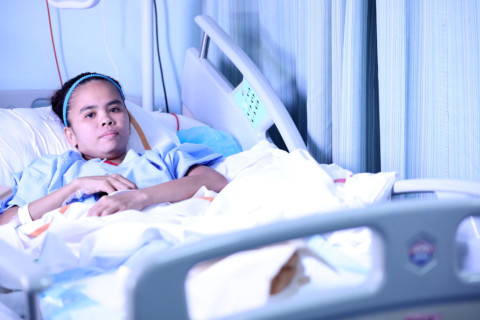
Dubai: Doctors at Rashid Hospital successfully completed a highly complicated grafting procedure to save the life of a Filipina expat who was left with exposed bones and muscle tissue after being run over by a car.
When 34-year-old Ana Marisa Perez went to walk her dog one Thursday morning, she would have never imagined that moments later she would be fighting for her life.
“I was crossing the road with my dog when I was hit by the car. I fell but the driver did not notice what happened and continued to run over my body. It was by the grace of God that another driver saw what was happening and told him to stop or I wouldn’t be here with you,” Perez recalls.
Perez was admitted to Rashid Hospital’s emergency room with serious injuries and having lost a large mass of skin from her groin to her left foot, exposing her bones and muscle tissues. She also sustained a pelvic and leg fracture.
After examining her, doctors came to the conclusion that an immediate grafting procedure was necessary to prevent any further complications.
Skin grafting is a surgical procedure that involves removing skin from one area of the body and moving it, or transplanting it, to a different area of the body.
However, Dr Khalid Al Awadi, Head of the Hand and Microsurgery Unit at Rashid Hospital, explained that in Perez’s case, using her own skin for grafting was not possible immediately because her bones and muscle tissues were exposed.
Instead, skin from a human corpse, also known as cadaveric skin — which is skin removed from a dead person before being processed and distributed by skin and tissue banks — was used.
“The first step we conducted was cleaning the wound and, due to its severe state, it required numerous sessions. Because the bones were exposed, there was no base to graft the patient’s skin on, so we decided to use cadaver skin and apply it on the exposed bones and tendon to act as a scaffold,” Dr Al Awadi said.
He added that five days after the successful grafting procedure and, after making sure that Perez’s body wouldn’t reject the new cadaver skin and adapted to it, the doctors started the second phase, which includes grafting the patient’s own skin and covering the cadaver skin and wound.
Dr Al Awadi explained that the procedure was necessitated so as to prevent the internal tissues from being exposed to microbes, moisture and pollutants in the air.
“All these factors will prevent the wound from healing and makes it more prone to infection,” he added.
Following the completion of both procedures in a couple of days, the doctors conducted tests and found that there were no infections, indicating that the patient’s body had accepted and adapted to the transplanted skin.
“The procedure was a complete success and she has completely recovered from the grafting surgery. She is now continuing her treatment with other departments at the hospital for the fractures she sustained and will hopefully discharge her soon in good health,” said Dr Al Awadi.
Commenting on the procedure from her hospital bed, Perez said she was pleased with the health care she received.
“I am so happy because I thought before that I will never walk again, seeing my foot recovering and moving and my skin intact is truly a blessing. I thank Rashid Hospital and my doctors for this,” she said.












